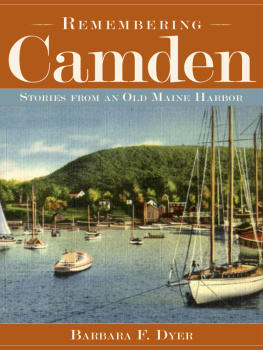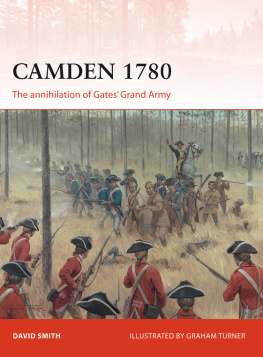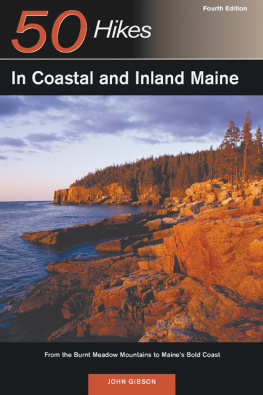

Published by The History Press
Charleston, SC 29403
www.historypress.net
Copyright 2007 by Barbara F. Dyer
All rights reserved
All images courtesy of Camden Area History Center, from Barbara F. Dyer Collection, unless otherwise noted.
First published 2007
e-book edition 2013
Manufactured in the United Kingdom
ISBN 978.1.62584.346.3
Library of Congress Cataloging-in-Publication Data
Dyer, Barbara F.
Remembering Camden : stories from an old Maine harbor / Barbara F. Dyer.
p. cm.
print edition ISBN 978-1-59629-321-2 (alk. paper)
1. Camden (Me. : Town)--History--20th century--Anecdotes. 2. Camden (Me. : Town)--Social life and customs--20th century--Anecdotes. 3. Camden (Me. : Town)--Biography--Anecdotes. 4. Camden Region (Me.)--History, Local--Anecdotes. I. Title.
F29.C2D938 2007
974.153--dc22
2007041971
Notice: The information in this book is true and complete to the best of our knowledge. It is offered without guarantee on the part of the author or The History Press. The author and The History Press disclaim all liability in connection with the use of this book.
All rights reserved. No part of this book may be reproduced or transmitted in any form whatsoever without prior written permission from the publisher except in the case of brief quotations embodied in critical articles and reviews.
Contents
Camdens Birth Certificate
Next May, it will have been 239 years since Camdens first settler, James Richards, sailed into Camden Harbor. He was followed by Major William Minot and Lewis Ogier. Then Robert Thorndike came the same year to Goose River with his brother, Paul Thorndike, and James Simonton. Then to Clam Cove came William Gregory, William Porter and William Upham.
By the time 331 people had settled in Camden, they felt it should have a town government. So on February 17, 1791, the plantation of Cambden became incorporated as the seventy-second town in the state. It had three readings in the House of Representatives, passed and signed by David Cobb, Speaker. Then it had two readings in the Senate, passed and signed by Samuel Phillips, president. It was approved by none other than John Hancock, who was governor of Massachusetts at that time. All three signers were leaders in the Revolutionary War.
The document read:
COMMONWEALTH OF MASSACHUSETTS
In the year of our Lord, one thousand seven hundred and ninety-one. An act to incorporate the Plantation of Cambden, in the county of Hancock into a town by the name of Cambden.
Be it enacted by the Senate and House of Representatives in the General Court assembled and by authority of the same, that the said Plantation called Cambden, included within the following boundaries, viz: Beginning at a rock marked A.X. on the seashore at the north side of Owls Head Bay at the southeast corner of Thomaston line; thence running northwest by north, seven miles, thirty-four poles, to a maple stake marked on four sides, and a pile of stones; thence running northeast, five miles, ninety-four poles, to a beech tree marked on four sides; thence running east three miles and one half and twenty poles, to a spruce tree marked on four sides; thence running south east by south, one mile to a fir tree marked on four sides at Little Ducktrap, in Penobscot Bay; thence by the sea shore in a westerly direction to the bounds first mentioned; together with the inhabitants thereon, be and they hereby are incorporated into a Town by the name of Cambden; and that the said Town be and hereby is, vested with all the Powers, Privileges and Immunities which other Towns in this Commonwealth may by law enjoy.
And be it enacted further by the authority aforesaid, that Oliver Parker, Esq.. of Penobscot be and hereby is empowered to issue his warrant, directed to some principal Inhabitant of said Town of Cambden, requiring him to notify the Inhabitants there of to meet at such a time and place as he shall therein appoint, to choose such Officers as Towns are by law required to choose at their annual meeting in the month of March or April.
Camden had been named for Lord Camden, who had been kind to the colonists, and the b in the spelling is believed to have been a mistake that was corrected in 1805.
In 1794, the commonwealth of Massachusetts had a law that any town would be fined for not having a gospel minister. Previous to that time there was very little preaching in Camden, except occasionally when a religious teacher would stop while passing through. Upon the speakers arrival, news would spread and a large congregation would gather for the privilege of hearing a sermon. There were about three ordained ministers within a hundred-mile radius.
Camden voted that David Blodgett and Saml Mclaughlin be the committee to draw up a petition to lay before the Supreme Court to be holden at Hallowell, against paying a fine for not having a minister for three years past.
However, the decision the committee handed down forced Camden to pay in full two pounds, fourteen shillings and six pence. After that, at town meeting, among other interesting articles, they voted to raise thirty or more pounds for support of the gospel.
Reverend Paul Coffin (believed to have been a Congregationalist) kept a journal, and wrote about his wonderful visit to Camden, where he stayed with Captain William McGlathery. He wrote about the fifteen neat houses and other buildings, making it a compact village. Today we might doubt the good ministers description of compact. Fifteen houses in Camdenwhich also included Goose River (Rockport), Clam Cove (Glen Cove), West Camden (West Rockport) and Rockvillecouldnt be considered compact today. Also the harbor was full of pleasant islands. The entry had been dated August 15, 1796.
The next year every citizen was required by the commonwealth law to pay a tax for support of a religious order. In desperation perhaps, some individuals from Camden built a meetinghouse a half mile from the J.C. Curtis store on the old post road. Today that location would have been on the northeast corner of Elm and Park Streets, across the road from Bank North, formerly known as Peoples Heritage Bank.

This is the first meetinghouse built in Camden.
A True Love Story
While studying the genealogy of the Hosmer family from 1635 to 1925, I found that it also included a touching love story. It had been written by the pseudonym of Frank, with fictitious names for the people involved. Mary Gibbs Hosmer, granddaughter of Nathaniel Hosmer, recorded the tale when she was about eighteen years old, and it was published in the Camden Advertiser in 1846.
This is a true story, in my words. The Twenty Associates granted to Charles Barrett land in Hope and Appleton in hopes he could entice people to settle the land. Nathaniel Hosmer accepted and built a log cabin so he could farm near what is now Hosmers Pond. (Fifty years ago it was Hosmer Lake.)
Nathaniel Hosmer came from Mason, New Hampshire. He went home the next winter and when he came to Camden again in the spring, he brought his sister and Job Hodgman. They married and took a farm nearby.
That summer Hosmer built a frame house and returned home to bring a lady to be his wife. She wanted very much to leave with him, but Mary Wheeler lived with a stepfather, David Blodgett. She also had a very determined mother, who had picked out a husband for her daughter: the son of a wealthy neighbor. Her mother had a difficult life, because of England and the Indians. Nothing would do except her daughter must marry someone who could give her an easy life.
Next page












